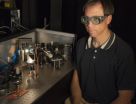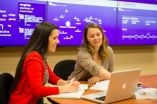(Press-News.org) Printable robots — those that can be assembled from parts produced by 3-D printers — have long been a topic of research in the lab of Daniela Rus, the Andrew and Erna Viterbi Professor of Electrical Engineering and Computer Science at MIT.
At this year's IEEE International Conference on Robotics and Automation, Rus' group and its collaborators introduce a new wrinkle on the idea: bakable robots.
In two new papers, the researchers demonstrate the promise of printable robotic components that, when heated, automatically fold into prescribed three-dimensional configurations.
One paper describes a system that takes a digital specification of a 3-D shape — such as a computer-aided design, or CAD, file — and generates the 2-D patterns that would enable a piece of plastic to reproduce it through self-folding.
The other paper explains how to build electrical components from self-folding laser-cut materials. The researchers present designs for resistors, inductors, and capacitors, as well as sensors and actuators — the electromechanical "muscles" that enable robots' movements.
"We have this big dream of the hardware compiler, where you can specify, 'I want a robot that will play with my cat,' or 'I want a robot that will clean the floor,' and from this high-level specification, you actually generate a working device," Rus says. "So far, we have tackled some subproblems in the space, and one of the subproblems is this end-to-end system where you have a picture, and at the other end, you have an object that realizes that picture. And the same mathematical models and principles that we use in this pipeline we also use to create these folded electronics."
Both papers build on previous research that Rus did in collaboration with Erik Demaine, another professor of computer science and engineering at MIT. This work explored how origami could be adapted to create reconfigurable robots.
All the angles
The key difference in the new work, explains Shuhei Miyashita, a postdoc in Rus' lab and one of her co-authors on both papers, is a technique for precisely controlling the angles at which a heated sheet folds. Miyashita sandwiches a sheet of polyvinyl chloride (PVC) between two films of a rigid polyester riddled with slits of different widths. When heated, the PVC contracts, and the slits close. Where edges of the polyester film press up against each other, they deform the PVC.
Imagine, for instance, a slit in the top polyester film and another parallel to it in the bottom film. But suppose, too, that the slit in the top film is narrower than that on the bottom. As the PVC contracts, the edges of the top slit will press against each other, but there will still be a gap between the edges of the bottom slit. The entire sheet will then bend downward until the bottom edges meet as well. The final angle is a function of the difference in the widths of the top and bottom slits.
But producing the pattern of slits is not as simple as just overlaying them on an origami crease pattern and adjusting the widths accordingly, Rus says. "You're doing this really complicated global control that moves every edge in the system at the same time," she says. "You want to design those edges in such a way that the result of composing all these motions, which actually interfere with each other, leads to the correct geometric structure."
ByoungKwon An, another of Rus' students, is lead author on the paper describing the system for interpreting 3-D images. He's joined by Rus, Miyashita, Demaine, and five other researchers both at MIT and in the lab of professor Robert Wood at Harvard University.
Current events
Miyashita is lead author on the other paper, whose coauthors include, in addition to Rus, researchers at the University of Zurich and the University of Tokyo.
In that paper, the researchers describe using a polyester coated with aluminum to create foldable electronic components. Miyashita designed those components by hand, since it was necessary to prescribe not just their geometric properties but also their electrical properties. The sensor Miyashita designed looks kind of like a small accordion. Each of the accordion folds contains a separate resistor, and when the folds are compressed, the total resistance changes proportionally, with a measurable effect on a current passing through the sensor.
The actuator — which would enable a robot to move — is a foldable coil, which would need to be augmented with a pair of iron cylinders that could be magnetized by an electrical current. Aluminum isn't a good enough conductor to yield an actuator that exerts much force, but a copper-coated polyester should do the trick.
INFORMATION:
Written by Larry Hardesty, MIT News Office
Additional background
ARCHIVE: Soft robotic fish moves like the real thing
http://newsoffice.mit.edu/2014/soft-robotic-fish-moves-like-the-real-thing-0313
ARCHIVE: Surprisingly simple scheme for self-assembling robots
http://newsoffice.mit.edu/2013/simple-scheme-for-self-assembling-robots-1004
New printable robots could self-assemble when heated
New algorithms and electronic components could enable printable robots that self-assemble when heated
2014-05-30
ELSE PRESS RELEASES FROM THIS DATE:
Radiation for prostate cancer linked to secondary cancers, study finds
2014-05-30
ANN ARBOR, Mich. — Among men treated for prostate cancer, those who received radiation therapy were more likely to develop bladder or rectal cancer, according to a new study from the University of Michigan Comprehensive Cancer Center.
"Overall the incidence of these cancers is low. But when men have received radiation treatments, it's important to evaluate carefully any symptoms that could be a sign of bladder or rectal cancer," says senior study author Kathleen A. Cooney, M.D., professor of hematology/oncology and urology at the U-M Medical School.
The study, which ...
Novel NIST laser system mimics sunlight to test solar cell efficiency
2014-05-30
Researchers at the National Institute of Standards and Technology (NIST) have developed a laser-based instrument that generates artificial sunlight to help test solar cell properties and find ways to boost their efficiency.
The novel NIST system simulates sunlight well across a broad spectrum of visible to infrared light. More flexible than conventional solar simulators such as xenon arc-lamps or light-emitting diodes, the laser instrument can be focused down to a small beam spot—with resolution approaching the theoretical limit—and shaped to match any desired spectral ...
Rush a light wave and you'll break its data, say NIST scientists
2014-05-30
Quantum information can't break the cosmic speed limit, according to researchers* from the National Institute of Standards and Technology (NIST) and the University of Maryland's Joint Quantum Institute. The scientists have shown how attempts to "push" part of a light beam past the speed of light results in the loss of the quantum data the light carries. The results could clarify how noise might limit the transfer of information in quantum computers.
The speed of light in vacuum is often thought to be the ultimate speed limit, something Einstein showed to be an unbreakable ...
Study suggests strong link between depression and early death among seniors with diabetes
2014-05-30
People with diabetes have about double the risk of premature death as people of the same age without diabetes. Studies also have shown that they have about twice the odds of suffering from depression, which further increases their mortality risk.
A new UCLA-led study published in the Journal of the American Geriatrics Society found that among adults 65 and older with diabetes, depression is linked with a far greater chance for early death compared with people of the same age who do not have depression.
The researchers suggest that the higher mortality rate among those ...
Hero or sissy? Study explores perception of injured athletes
2014-05-30
NFL teams shoulder most of the blame for players' injuries and sports journalists can shift football cultural norms toward valuing players who put their health first.
These are the key findings of a new study authored by Clemson University researchers Jimmy Sanderson and Melinda Weathers that examined health and safety issues in sports. It was published in the journal Communication & Sport.
"Media coverage of players who decide to sit out or play through an injury may impact players' future decision-making as well as fans' attitudes towards these players," said Sanderson.
"Sitting ...
Australia's deadly eruptions the reason for the first mass extinction
2014-05-30
A Curtin University researcher has shown that ancient volcanic eruptions in Australia 510 million years ago significantly affected the climate, causing the first known mass extinction in the history of complex life.
Published in prestigious journal Geology, Curtin's Associate Professor Fred Jourdan, along with colleagues from several Australian and international institutions, used radioactive dating techniques to precisely measure the age of the eruptions of the Kalkarindji volcanic province.
Dr Jourdan and his team were able to prove the volcanic province occurred ...
X-ray pulses on demand from electron storage rings
2014-05-30
Everything we know nowadays about novel materials and the underlying processes in them we also know thanks to studies at contemporary synchrotron facilities like BESSY II. Here, relativistic electrons in a storage ring are employed to generate very brilliant and partly coherent light pulses from the THz to the X-ray regime in undulators and other devices. However, most of the techniques used at synchrotrons are very "photon hungry" and demand brighter and brighter light pulses to conduct innovative experiments. The general greed for stronger light pulses does, however, ...
Glow-in-the-dark tool lets scientists find diseased bats
2014-05-29
Scientists working to understand the devastating bat disease known as white-nose syndrome (WNS) now have a new, non-lethal tool to identify bats with WNS lesions —ultraviolet, or UV, light.
If long-wave UV light is directed at the wings of bats with white-nose syndrome, it produces a distinctive orange-yellow fluorescence. This orange-yellow glow corresponds directly with microscopic skin lesions that are the current "gold standard" for diagnosing white-nose syndrome in bats.
"When we first saw this fluorescence of a bat wing in a cave, we knew we were on to something," ...
Police reform law underenforced by Department of Justice
2014-05-29
CHAMPAIGN, Ill. — A law designed to combat police misconduct is hamstrung by limited resources, a lack of transparency and "political spillover" at the U.S. Department of Justice, says a recently published empirical study by Stephen Rushin, a law professor at the University of Illinois and expert in criminal law and policing.
In 1994, Congress passed 42 U.S.C. Section 14141 as part of the Violent Crime Control and Law Enforcement Act, granting the U.S. attorney general the power to initiate structural reform litigation against local police departments engaged in a pattern ...
Powerful tool combs family genomes to find shared variations causing disease
2014-05-29
(SALT LAKE CITY)—Scientists at the University of Utah (U of U), the University of Texas MD Anderson Cancer Center in Houston and colleagues have developed a powerful tool called pVAAST that combines linkage analysis with case control association to help researchers and clinicians identify disease-causing mutations in families faster and more precisely than ever before.
In a study in Nature Biotechnology, the researchers describe cases in which pVAAST (the pedigree Variant Annotation, Analysis and Search Tool) identified mutations in two families with separate diseases ...
LAST 30 PRESS RELEASES:
Bluey’s dad offered professorial chair in archaeology at Griffith University
Beyond small data limitations: Transfer learning-enabled framework for predicting mechanical properties of aluminum matrix composites
Unveiling non-thermal catalytic origin of direct current-promoted catalysis for energy-efficient transformation of greenhouse gases to valuable chemicals
Chronic breathlessness emerging as a hidden strain on hospitals
Paleontologists find first fossil bee nests made inside fossil bones
These fossils were the perfect home for ancient baby bees
Not everyone reads the room the same. A new study examines why.
New research identifies linked energy, immune and vascular changes in ME/CFS
Concurrent frailty + depression likely boost dementia risk in older people
Living in substandard housing linked to kids’ missed schooling and poor grades
Little awareness of medical + psychological complexities of steroid cream withdrawal
Eight in 10 trusts caring for emergency department patients in corridors, finds BMJ investigation
NASA’s Webb telescope finds bizarre atmosphere on a lemon-shaped exoplanet
The gut bacteria that put the brakes on weight gain in mice
Exploring how patients feel about AI transcription
Category ‘6’ tropical cyclone hot spots are growing
Video: Drivers struggle to multitask when using dashboard touch screens, study finds
SLU research shows surge in alcohol-related liver disease driving ‘deaths of despair’
Rising heat reshapes how microbes break down microplastics, new review finds
Roots reveal a hidden carbon pathway in maize plants
Membrane magic: FAMU-FSU researchers repurpose fuel cells membranes for new applications
UN Member States pledge to increase access to diagnosis and inhaled medicines for the 480 million people living with COPD
Combination therapy shows potential to treat pediatric brain cancer ATRT
Study links seabird nesting to shark turf wars in Hawai‘i
Legal sports betting linked to sharp increases in violent crime, study finds
Breakthrough AI from NYUAD speeds up discovery of life-supporting microbes
New Eva Mayr-Stihl Foundation funding initiative boosts research at University of Freiburg on adaptation of forests to global change
The perfect plastic? Plant-based, fully saltwater degradable, zero microplastics
Bias in data may be blocking AI’s potential to combat antibiotic resistance
Article-level metrics would provide more recognition to most researchers than journal-level metrics
[Press-News.org] New printable robots could self-assemble when heatedNew algorithms and electronic components could enable printable robots that self-assemble when heated





